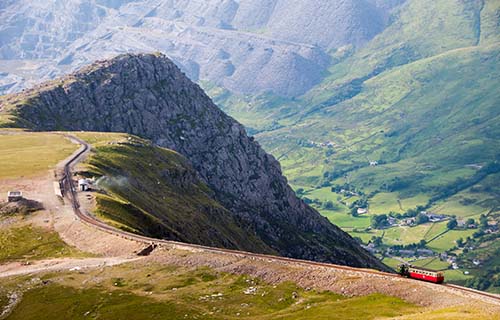With over 150,000 miles of footpaths crisscrossing the four corners of the country, 15 National Trails and the same number of National Parks, it’s fair to say the UK is a haven for hikers. From remote Highland retreats to mountain tops with endless panoramas, coastal treks navigating sub-tropical gardens and fossil-lined beaches to family-friendly hikes that epitomise the magic of the Lake District, the UK is best explored on two feet (and a comfy pair of hiking boots).
Whether you’re looking for a gentle coastal ramble, a three-week trek along the backbone of Britain or a mountainous scramble, our Premier Inn guide covers all the most amazing routes. We’ll also give you some top tips on the best time of year to take a hike, the sights to look out for on the way and – naturally – the best pubs en route. Plus, we’ve got a list of the essential kit you’ll need and answers to some of the most common hiking questions. So, strap on those hiking boots, zip up your waterproof coat and get planning your next two-footed adventure - what will you do?
The ultimate guide to hiking and walking in the UK
Coastal walks
We’ve hand-picked the best coastal treks in the UK – and considering there are over 7,000 miles of coastline to choose from, that wasn’t an easy job. Covering everything from family-friendly walks to two-week treks that explore some of the most remote wilderness in the UK .
Mountain walks
There can be few better feelings than conquering a mountain, reaching its summit and being greeted with panoramic hundred-mile views, high fives and sweaty smiles from other hikers. From the highs and lows of the Lake District, Snowdonia, the Yorkshire Dales and dozens more, the UK has some fantastic hill and mountain trails, which we’ve rounded up below.
Countryside walks
From quick Lake District scrambles to week-long treks that navigate Britain’s backbone, and limestone geological wonders to mountain hikes designed to put SAS candidates to the test, our round-up of the best countryside walks in the UK is a suitably varied read. Ranging from three-mile round trips to 268-mile epics, there’s something for everyone.
Woodland walks
The UK has long had a reputation as a green and pleasant land, and while farmland might account for most of that, a lot of Britain is covered in leafy forests with around four billion trees providing 15% woodland cover. Our roundup of the best woodland hikes in the country spans the largest man-made forest in England, the untouched medieval majesty of Hatfield Forest, the wild ponies of the New Forest, natural art installations and much, much more.
Landmark walks
While walking is often its own reward in the UK thanks to the big skies, endless views and the sense of achievement as you scale a mountain (or hill), ticking off a world-famous landmark en route is even more rewarding. From quick two-hour hikes that deliver jaw-dropping views across Edinburgh to 90-mile excursions traversing Hadrian’s Wall, we’ve compiled the UK’s best landmark walks.
Jim’s Premier Inn Adventures
Jim from Plymouth achieved a long-term ambition to walk 630 miles of the South West Coast Path between Minehead and Poole, completing 470 of them either side of the lockdowns in 2020.
Throughout 2020, keeping safe was his main priority and says he couldn’t have completed his quest without the reliability, safety and comfort of Premier Inn hotels – the only place he stayed at across the South West. His path covered off a variety of places with stays in our hotels across Helston, Seaton, Bideford, Camborne, Penzance, Newquay (Fraddon), Bude, Weymouth and Bournemouth.
The essential hiking kit list
Walking is one of the simplest and most accessible forms of exercise. But whether you’re out for a quick stroll, embarking on a week-long trek or climbing to the top of your nearest peak, having the right walking gear will help make your trip more comfortable and enjoyable. Why not take a look at one of the UK’s most picturesque walks according to Instagram?
Hiking clothes
A good pair of walking boots or sturdy shoes are essential for any hike, as are a pair of comfy thick socks. Try and break in any new boots by wearing them around the house for several days before using them on a hike: A blister – or three – can be a swift and painful end to your day’s walking.
Lightweight, durable, quick-drying trousers (not jeans) are best, possibly fitted with zip-off shorts if you’re hiking in the summer.
When it comes to the top half, three layers of clothing is a good starting point. With a thermal long-sleeve as your base layer, a fleece as your mid-layer and a lightweight waterproof jacket on top, you’ll be able to retain your body heat and have plenty of options to adapt to the weather. Layers are a great way to adjust to the temperature, so it’s a good idea to pack more in your bag.
A warm hat and sun hat, ideally covering your ears and neck, is a good way to beat the cold or stay in the shade, but you’ll also need gloves for winter hikes.
Navigation
What navigation equipment do I need for my hike?
- Compass and the relevant set of maps – Ordnance Survey Maps are the most detailed and comprehensive
- Phone/watch with GPS and online maps
- Phone battery charger and pack if you’re relying on phone GPS and online maps
Your bag
Ensure you have a waterproof rucksack or cover the inside with bag liners if not. If you can, get a bag with adjustable straps and several compartments. And which items should I pack for a hike?
- Extra layers
- Sunglasses
- Lip balm
- Torch
- Waterproof matches/lighter
- First aid kit
- Multi-tool
- Emergency shelter for longer, more exposed walks
Food and drink
What food and drinks should I take with me on a hike?
- A packed lunch
- Two litres of water per person (a rough guide is one litre for two hours of walking)
- Snacks including fruit, dried fruit and nuts and energy bars
- Check out our ideas (below) of what to take for a long hike

Coastal walks | Mountain walks | Woodland walks | Countryside walks | Landmark walks
FAQs
Q) How intensive is hiking as an exercise?
A) A leisurely stroll on flat, even ground at an average pace of two miles per hour will burn around 200 calories an hour. If you were climbing, you’d expect to burn around 450 calories per hour. The key is the intensity of the hiking – the more metres climbed, and the faster you push yourself, the more energy you’re going to burn.
Whether you’re climbing a Lake District mountain, rambling along the South West Coast Path or trekking along Hadrian’s Wall, you’ll need to stay hydrated and keep your energy levels up. Try to budget for one litre of water every two hours, especially for longer and harder hikes. Also take high-energy snacks with you, including nuts and dried fruit.
Q) How long will my hike take?
A) A good average pace on flat ground is around two to three miles an hour. If you’re climbing, it’ll take approximately an hour to scale 300-metres. The more unsteady the terrain and the more altitude you have to cover, the slower your pace will be. More experienced hikers may be able to cover up to four miles an hour over flat terrain (and fell runners can even go up and down Ben Nevis in under two hours). The key is to know your own pace and budget your energy levels by keeping track of how far you’ve gone and how far is still left to go.
You can also choose to become a member of a charity. The RSPB is just one example. It’s the largest conservation charity in the UK, with projects and reserves spanning the nation and helping all kinds of wildlife, not just birds. Or, you can choose to adopt an animal with the Wildlife Trusts for a monthly fee that’ll help to support wildlife conservation work in the UK.
Q) What can I do to avoid injury during hiking?
A) Walking and hiking are some of the best forms of low impact exercise, but there can be associated risks including twisting an ankle, sore feet and pulled muscles. To minimise these, make sure you’re prepared for the hike in advance by ensuring your hiking boots fit well and have been well-walked in. If you’re scrabbling up steep peaks in the Lake District or Snowdonia, walking poles might help with your balance, and hiking boots that cover the ankle will help protect sensitive joints (and prevent water seeping in over the top). Double-check the route is suitable for your fitness and experience levels, start off slowly to get your muscles warmed up, ensure that your rucksack isn’t too heavy and make sure your shoes or boots are properly tied and fit well – boots that are too loose or too tight could cause blisters.
Q) What is the difference between hiking and trekking?
A) Hiking is generally considered more of a leisure activity covering popular trails and man-made paths taking a day or two. Trekking is a more challenging journey, covering adventurous ground and sometimes taking days or even weeks to finish. Either way, whatever you decide to call it, the aim for both is still the same – to get exercise, explore the countryside and have fun!
Q) How can weather conditions affect hiking?
A) When the sun is shining and the miles fly by, hiking can seem pretty easy. But the unpredictable nature of UK weather means that the perfect hiking conditions probably won’t last for long. And when the weather does close in, bringing with it fog, rain, hail or snow, it can drastically affect hiking. The onset of fog might mean you can’t see further than five metres ahead, while a snow blizzard will bring the temperature right down and affect visibility. Equally, hiking in the middle of the summer brings its own potential problems including dehydration and sunburn.
Check the weather conditions before you set off. Also, pack enough clothing to adapt if the weather changes and even a temporary shelter if you’re hiking in a remote area that is known for bad weather.
Q) Where can I find hiking routes near me?
A) As well as the dozens of tried-and-tested routes included in this guide, there are plenty of other organisations including the National Trust, The National Trail, Discover Britain and the Wildlife Trust who produce in-depth guides spanning the UK.





